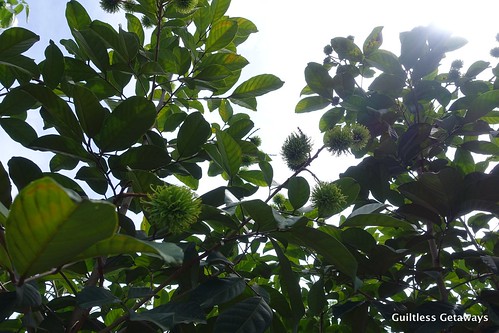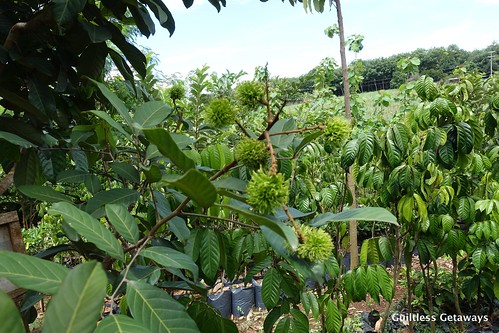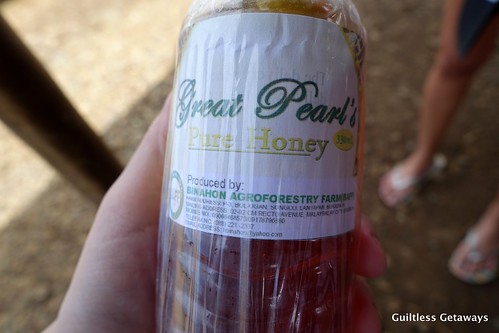I'm starting to love the outdoors despite my aversion to the sun. A well-paced early morning eco walk around the Binahon Agroforestry Farm property with the Binahon mini forest did wonders no matter what I was going through that crazy day. I love the trees here most planted in barren land over 20 years ago. Coming here is an opportunity to marvel at how things heal, grow, and give back over time and look at your impact on your physical, social and cultural environment. The Binahons have created a lovely retreat place and a valuable resource center for researchers and forestry students in Mindanao. Our guide and owner Mr. Henry talked about us being stewards of the good resources and understanding the language of the ecosystems and the environment so that you don't go against nature while doing farming.

The walk began with a garden full of ideas and waste - something very close to us, right next to our lodging area. Recognize the cup noodles and other common household items we usually throw away? This area is for converting waste into resources, food and income. "In a natural world, there is no such thing as waste."



How about using timber you personally grew to make your dream shed or house?

For the owner, the farmers can and must be all of these:
1. understand agrieconomics - productivity or to produce, profitability, sustainability and the maintenance of relationships with microorganisms, family relations, community, social system and spirituality
2. apply agriecology - the farm will contribute to watershed protection, biological diversity improvement, conservation of the right of wildlife, indigenous knowledge of systems and practices, address climate change concerns and disaster risk reduction
3. practice agriscience - conduct their own field trials and experimentation, farmer-friendly research and market research
4. be an agricator - an educator, do extension to other farmers interested in farming systems, conduct farmer and OJT training, exchange of info and interaction with forestry students, have a farmers starting and learning center then go beyond Philippine borders
5. be knowledgable in agritecture (like in Penalosa Farms in Negros!) - to attract visitors, improve sanitation and farm aesthetics and diversify attractions, be a space for outdoor activities, organize events and trainings, provide food and accommodation

BAFF is one of the top 10 seedling suppliers of Mindanao. One thing that's interesting in their intro the night before was the presentation of their financial statement ;) From the time they started in 1992, their assets grew to Php 44 million in 2014, not including the trees yet. Here, Mr. Binahon was talking about the versatile bamboo that can be used as planting material, a woodsource, a BBQ stick and many more.

Another economic activity, aside from trainings, bee farm, food and accommodation, and catering services, is their value-adding carrot processing plant. This way, they are providing market options and jobs to the people here. He said that they are not in competition with farmers and sharing is important because food security is everybody's concern.

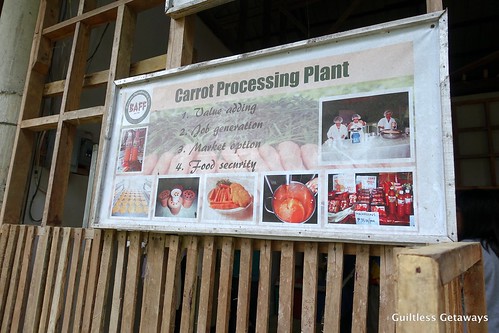

I loved this next part! It's not hard to believe that this mini forest protects the community from strong winds by reducing pressure of the wind and minimizing evaporation.


I learned from our next eco walk at the Maputi Trail that this is a wild pine tree... Like people, there are trees that tolerate shade and those that like the sun so they also coexist in this forest (hindi sila agawan sa taas).

Birds also like to visit here for food. I think I got it haha - They eat the fruits of rattan then they bring in new seeds. As they eat the fruit, they poo and these are ready to germinate. BAFF then collects these as a potential economic activity. =) I believe that one of the fortes of Mr. Binahon is how to propagate and germinate plants and trees.
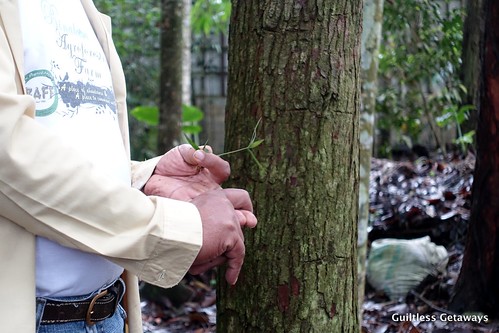
Speaking of rattan, he said their ubod (or core) is edible and the thorns disappear as they mature. They observed that the rattan is the one left standing in Yolanda because it sticks pretty well...

As in you and your clothes can get tangled and slashed in these thin rods in this forest so you have to be very mindful.



My height advantage includes easily getting through this natural cave hehe.

These beautiful barigated plants were placed here for ornamental purposes =)

There is evidence of El Nino here (cracked soil) in some parts and the path is generally easy to walk. As an added info, Mr. Binahon said that every time you see the brown river water, it signals that the upland is experiencing trouble (may sugat).


Here's the rest of the trail =) It was a great 30-minute walk full of things to see and stuff to watch out for. Hehe.



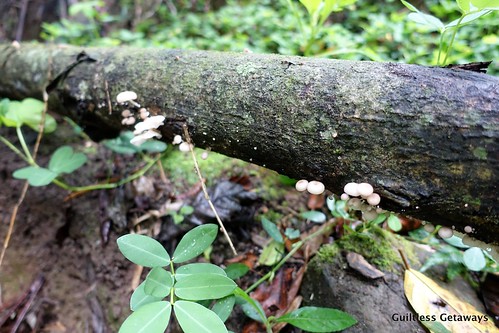

I strongly advise this method if ever you're in a forest. Wear leggings then put the sock over it! It doesn't look pleasing but it will save you a lot and you'll get to enjoy the experience more without having to scratch away. There were a lot of big ants BTW. Nature is diverse so even predators exist and has a role in protecting you in their own way. =)


We came to a clearing and I started looking down and around. Haha.

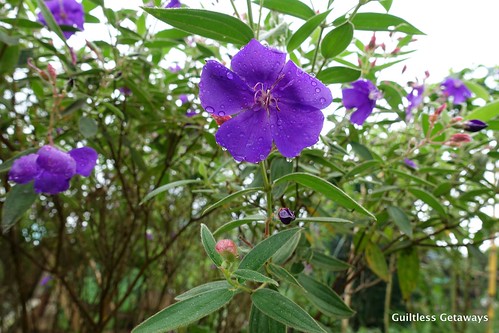
Remember the mani-mani from Jaya's Garden?


Didn't know you could do this with coffee beans!


Here, OJTs are taught how to propagate with their hands so this is a no-gloves zone hehe.


It takes 18 months for arabica coffee to be more aromatic and they are ready to sell!

I believe this is the area where they plant guapples (guava) to feed the turkey naturally.

He said that there are pests in monoculture so you have to use chemicals and that nature will revert to diverse characteristic. Nature will tell you to go back to diversity.


That's Mt. Kalatungan, a volcanic mountain 2880 masl ranked around 5th highest mountain in the Philippines.

The Binahon's farming design is dependent on the natural system in terms of spacing.

No spacing because they believe that land has the capacity to produce in different levels.
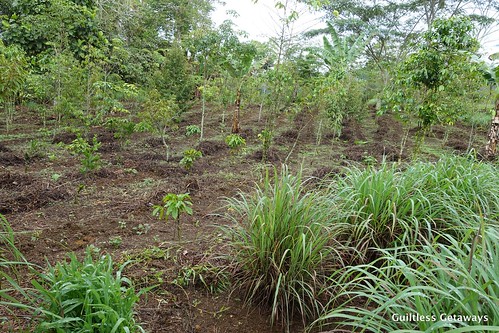


We stopped by the row of "perpunpula" red trees (still looking for the tree name!). They looked so beautiful, esp. if lined like this...





One method I've never heard yet is (Sustainable Organic Upland Practical) SOUP Farming.


They have around four fenced land like this then maximize the energy of the livestock and plant sweet potato. They put goats in area #1 so that they will cut the grass, then transfer them to the area #2. Meanwhile, they put the pigs in area #1 for land preparation and move to area #2 while the goats transfer to area #3. Then they plant camote in area #1 and so on rotating animals and crops. They choose camote because is more resistant to drought. Here, knowledge of the characteristics of plant diversity is important. In case of drought, there are plants designed to be resistant and can live with less water. Mr. Binahon said that people think you are poor when you say you plant sweet potato but you are not that dependent on input when you choose this plant, all parts are edible and easy to cultivate. A weakness of this SOUP system is the caretaker, not the livestock or the plant.

I definitely need somebody beside me who can identify pretty plants hehe.

I wonder how many workforce they have here to cultivate all these..

BAFF also has camping grounds. I didn't see any CRs but there must be one somewhere haha.




We went back thru the forest trail again to get to the organic fertilizer production area.


Huh, grow bags can be lined this way vertically also!


I believe BAFF uses bokashi and carbonized rice hull like Mr. Costales.


Mr. Binahon adds that he will do farm demonstration and not street demonstration to be less dependent on commercial fertilizers. He experiments on yakult lactic acid bacteria, beer as a source of yeast, seaweed lato and other indigenous bacteria for his concoctions. Another interesting thing to note is his teaching style... He instructs the OJTs by batches. On the first week, he trains them then lets the 1st batch train the 2nd batch with his supervision so that the students become trainees to trainors!
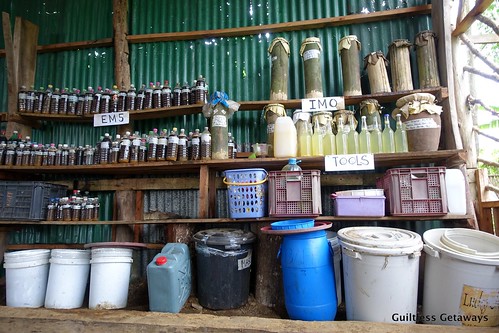

We had some free time to explore and I found this colorful garden seat set made of tires =)

Then he got some edible ferns for the lunch salad hehe.




We headed to two other BAFF sites briefly situated near the highway, which is actually pretty with lined trees.
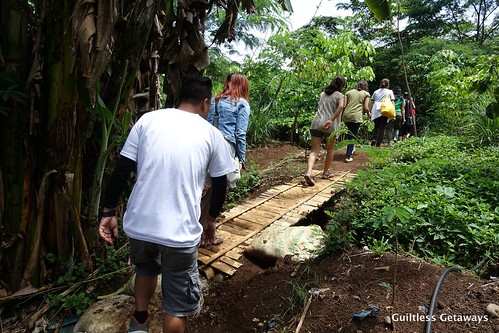
I asked Ms. Perla Binahon about this netted area here and she told me that this was a calamansi and citrus isolation chamber so that they prevent white flies from infesting the plants.

Coffee trees want around 25% to 30% shade, she said, so they do this! =) And if the trees bear fruit at the crown then they are sun-loving plants, if they bear fruit at the side like coffee then they are shade-loving...

Lastly, we went to pick up their honey! The beekeepers, flower growers and nursery growers here in BAFF are the women. I would have loved to extend my stay here but more for next time =)
Farm Details:
Sitio Bol-ogan, Barangay Songco
Lantapan Municipality,
Province of Bukidnon, Philippines
binahonagroforestryfarm@gmail.com
To visit the different ATI-assisted projects (Organic Farming Learning Sites), you can drop by or ask the ATI Regional Training Center nearest you or inquire through:
Call -
982AGRI (982-2474) for Metro Manila calls
1-800-10-982AGRI (1-800-10-9822474) for provincial toll-free calls using PLDT landlines
Text -
For Smart and Talk & Text Subscribers, send a message to 391-DA (391-32).
For non-Smart Subscribers, send a message to 0920-946AGRI (0920-9462474).





